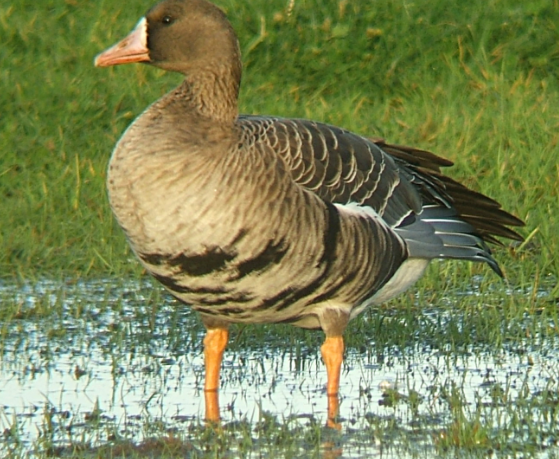Wildfowl, such as ducks, swans and geese, are web-footed birds that live on, in and near water. Ducks are the smallest of these, and therefore more likely to visit a pond in a country garden. Rails, such as coots and moorhens, are smallish, shy birds that live near slow-moving water – to attract them you could try creating large areas of bog garden near your pond. Herons may also visit if you have fish.
• Ducks are born with feathers, and ducklings can be seen swimming soon after hatching.
• There are three groups of ducks: surface-feeding or dabblers, which feed in shallow water by dipping and dabbling; divers, which go to greater depths than the dabblers; and sawbills, which dive for plants and fish.
• Geese are generally bigger than ducks but smaller than swans, and have stout legs so that they can walk and graze on meadows and marshes.
The male has a breeding plumage of a dark green head, while the female has a brown head and a green flash on the wings. It is very common on ponds and lakes, and grows to about 55 cm (22 in) from bill to tail. It feeds by upending and surface dabbling and can take off into flight straight from the water. Mallards can become tame.
Common on marshes and meadow ponds, this goose has a white blaze or line between the pink or orange bill and face, and grows up to 75 cm (2½ ft) long. It can be seen in large flocks in the UK, Europe, Russia and Canada. You might see one close at hand if your pond is in the country and close to marshes and water meadows
This swan has an orange-yellow bill with a black knob at the base. About 1.5 m (5 ft) long, it is bigger than Cygnus columbianus (Bewick’s Swan; Tundra Swan; Whistling Swan). At a distance, it can be confused with Cygnus cygnus (Whooper Swan) since it has a similar body shape and feeds in
open water. If your pond is near to fields and/or water meadows, you might have visiting swans. Some people keep domestic ducks and geese specifically to attract in wild species.
• Geese and swans are more likely to be seen in large country gardens than in small gardens.
POINTS OF INTEREST
• There are three groups of ducks: surface-feeding or dabblers, which feed in shallow water by dipping and dabbling; divers, which go to greater depths than the dabblers; and sawbills, which dive for plants and fish.
• Geese are generally bigger than ducks but smaller than swans, and have stout legs so that they can walk and graze on meadows and marshes.
| Keeping domestic geese will help to attract a wide variety of wild species to your pond. |
The male has a breeding plumage of a dark green head, while the female has a brown head and a green flash on the wings. It is very common on ponds and lakes, and grows to about 55 cm (22 in) from bill to tail. It feeds by upending and surface dabbling and can take off into flight straight from the water. Mallards can become tame.
Anser albifrons - White-fronted Goose
Cygnus olor - Mute Swan
open water. If your pond is near to fields and/or water meadows, you might have visiting swans. Some people keep domestic ducks and geese specifically to attract in wild species.
• Rails prefer slow-moving water with plenty of reeds, and are characteristically shy. To
see them, you will need to have large areas of swampy, marshy water and keep a careful
lookout.
• Generally, rails feed on invertebrates, fruit, seedlings and some small tender plants.
lookout.
• Generally, rails feed on invertebrates, fruit, seedlings and some small tender plants.
HERONS
If you are one of those gardeners whose big pleasure in life is having a huge open pond stuffed with fish, then herons are going to be an annoyance, simply because they will be attracted by the easy eating. However, if you have a muddy-edged wildlife pond with a broad range of creatures – fish, frogs, newts and so on – and if the pond is generously planted with trees and shrubs all around it, then the creatures in the pond will at least have a fighting chance, and the heron will be presented with more of a challenge.
STUDYING WATER BIRDS
The easiest way to study water birds in your garden is simply to sit and watch them feeding, swimming, grooming and so on. The next step is to get a pair of binoculars, a digital camera with a good long-distance lens, and a diary or notebook in which to record your sightings. If you have a hide (see page 39) from which you can observe without being seen, so much the better, especially for the more timid rails
Fulica atra - Coot
A duck-like bird with black plumage, a white shining bill that runs high up onto the forehead, and long legs that trail during flight. Coots are much more aggressive than moorhens, to the extent that they will actively attack to defend their territory.
Gallinula chloro - Moorhen
This duck-like bird has black-brown plumage, green legs and a red bill. The name comes from the Old English word ‘more’ or ‘moor’, meaning boggy or swampy. It grows to about 30 cm (1 ft) long. The walking and swimming actions are both slow and jerky, as if the birds are being cautious.
While your water garden is getting established, a family of domestic ducks (here Muscovy ducks) can provide a huge amount of pleasure for you and your children. |






Comments
Post a Comment